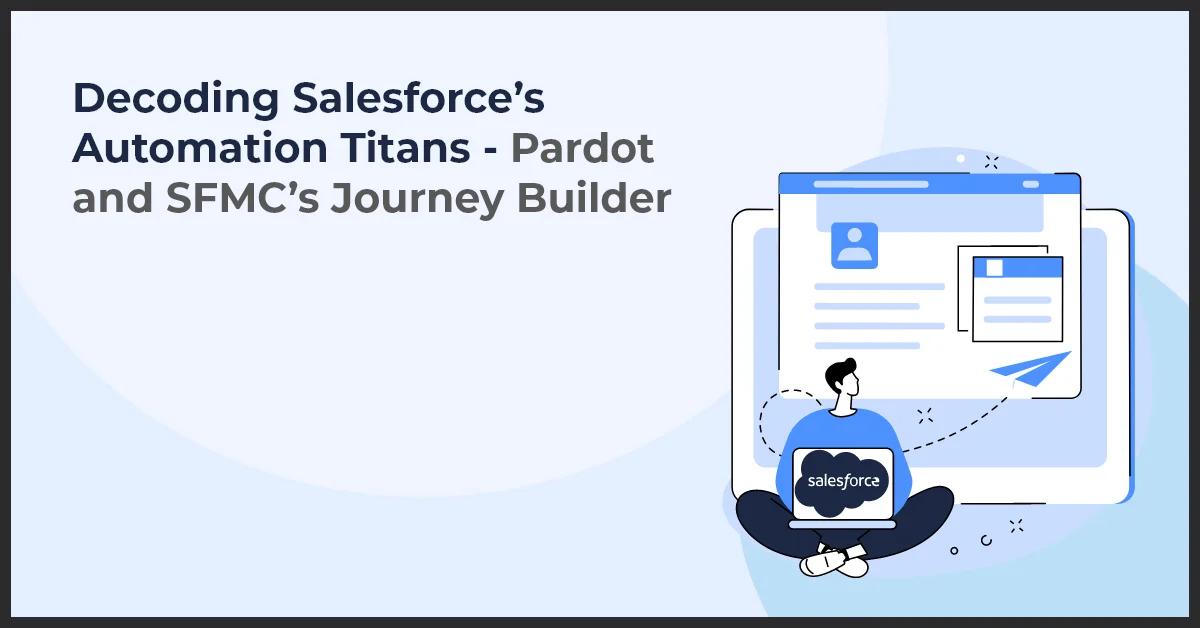Leveraging Middleware Integrations to Elevate the Performance of Your Salesforce Platform

Published on: January 20, 2023
Updated on: June 27, 2024
729 Views
- Salesforce
8 min read
In the fast-paced realm of modern business, staying ahead of the curve is not just a goal – it's a necessity. For organizations relying on Salesforce as their CRM backbone, the quest for optimal efficiency and performance is perpetual.
That's where the game-changing concept of middleware integrations enters the scene. Middleware Salesforce integration might be the answer you're seeking! Middleware has emerged as a powerful tool to optimize the performance of integrated environments, and when used with Salesforce, it can lead to significant improvements.
In this blog post, we'll delve into what middleware is, how it benefits Salesforce integration, the different types of middleware solutions, and factors to consider when choosing a middleware. By the end, you should better understand how Middleware can help you get the most out of your Salesforce instance.
What is Middleware Integration?
Middleware is a crucial intermediary between different software applications, enabling seamless data exchange and facilitating smooth interoperability among various systems, including Salesforce. When data is transmitted from one application, Middleware processes and converts it into a format compatible with the receiving application, facilitating frictionless communication between disparate systems.
Why Do Businesses Need Middleware Integration?
Salesforce's high level of configurability contributes significantly to its flexibility but at the cost of potential performance issues if not properly optimized. Some key bottlenecks are:
- Data Skew Issues:
Uneven data distribution causes uneven load concentration
- Integration Inefficiencies
- Excessive synchronous API calls from integrated applications
- Duplicate records inserted by faulty integrations
- Concurrency lock errors due to transaction collisions
- Inefficient Coding and Customizations
- Complex triggers, workflows, and automation
- Missing selective indexes
- Unoptimized code causing excessive client-side rendering
Middleware solutions can alleviate many platform performance pains for integrated environments by acting as a shock absorber between Salesforce and connected systems:
- Data Processing Efficiencies
- Asynchronous queued processing
- Batch data synchronization taking the load off Salesforce
- Caching frequently accessed data
- Integration Optimization
- API management capabilities, such as rate limiting and access control
- Compression and streaming for optimized data flows
- Even workload distribution via load balancing
- Resilience Enhancements
- Handling transient errors and automated retry mechanisms
- Error capturing for easier diagnosis of root causes
The right middleware design empowers technical teams to scale growing business demands without running into Salesforce bottlenecks or slowing down integrated ecosystems.
Common Types of Middleware integrations
There are many different types of Middleware used in Salesforce integrations, but some of the most common include:
- Enterprise service bus (ESB): An ESB is a software application that connects different applications and systems. Utilize it to route messages between applications, transform data, and provide other services such as security and monitoring.
Some popular ESBs include MuleSoft Anypoint Platform, TIBCO ActiveMatrix, and IBM WebSphere MQ.
- Integration platform as a service (iPaaS): A cloud-based platform, an iPaaS provides a suite of integration services, such as data integration, application integration, and process integration.
Some popular iPaaS platforms include Jitterbit Harmony, Dell Boomi AtomSphere, and SnapLogic Enterprise Integration Platform.
- API management platforms: An API management platform, as the name suggests, helps organizations manage their APIs. It can publish APIs, secure APIs, and monitor API usage.
Some popular API management platforms include the MuleSoft Anypoint Platform, Apigee Edge, and Axway API Gateway.
- Data integration platforms: A data integration platform is a software application that helps organizations integrate data from different sources. Use it to extract, transform, and load (ETL) data and replicate data between systems.
Some popular data integration platforms include Informatica Cloud, Talend Open Studio for Data Integration, and IBM InfoSphere DataStage.
The type of middleware best for a particular Salesforce integration will depend on your specific needs. For example, an ESB may be a great choice if you need to integrate with many different systems. If you require to integrate data from different sources, then a data integration platform may be better.
Once you’ve chosen a middleware, implement and configure it to meet your specific needs. This may involve developing custom code, creating connectors, and configuring security settings.
Benefits of Middleware
- Optimized Data Flow: Middleware streamlines data transmission between applications, enhancing efficiency and productivity by reducing latency and promoting timely data exchange.
- Prevent Redundant Data Entries: By ensuring that data is accurately and seamlessly transferred between systems, Middleware integration eliminates the need for redundant data entries, preventing duplicated efforts and ensuring the consistency and reliability of data across the organization.
- Enhanced System Communication: Middleware fosters improved communication among diverse systems, enabling them to collaborate effectively. This facilitates better decision-making and enhances the overall operational performance of the organization.
When To Use Middleware Integration in Salesforce?
Here are some scenarios when it is beneficial to use Middleware integration in Salesforce:
- Data transformations: Middleware integration is useful when data received from an external system needs to be transformed into a format that Salesforce can easily consume. Instead of performing these transformations within Salesforce, which can be resource-intensive and lead to governor limit issues, middleware platforms provide robust data transformation capabilities that offload this workload from the platform.
- Managing large data volumes: Middleware integration is designed to handle the transfer of large amounts of data more efficiently than native platform tools. This is because middleware is built to optimize data transport, minimizing the number of individual API calls and reducing the overall network overhead. It makes Middleware an ideal solution when dealing with large datasets.
- Synchronizing data between multiple systems: Middleware integration is strongly recommended when multiple systems need to be synchronized with Salesforce. By decoupling the synchronization process from Salesforce and managing it through Middleware, you can ensure a more reliable and scalable approach to maintaining data consistency across systems.
- Complex integration scenarios: When dealing with complex integration scenarios that involve two or more systems, Middleware integration can provide a streamlined approach to managing the interactions. Middleware is designed with these scenarios in mind and often offers features such as error handling, retry logic, and queueing mechanisms that simplify integration management.
That said, there are also situations where middleware integration may not be the best choice, such as:
- Simple integration scenarios: When only a single, simple integration is required, middleware integration may introduce unnecessary complexity. In these cases, using native platform tools or lightweight integration frameworks may be more appropriate and cost-effective.
- Existing expertise with platform tools: If your team has extensive knowledge and experience with Salesforce's native integration tools, such as Salesforce APIs, Apex, and Lightning Connect, it may be more efficient to leverage these skills rather than learning and implementing a new Middleware platform.
- Short project timelines: Implementing Middleware integration can involve a learning curve and additional setup and configuration. If project timelines are tight, relying on simpler integration methods to expedite the process may be more practical.
10 Factors to Consider When Selecting Middleware Salesforce Integration
Here are some factors to consider when selecting middleware for your Salesforce integration:
- Usability: Evaluate the ease of installation, complexity of getting started, administration dashboards, and overall developer experience. The solution should be easy for your team to set up, learn, and manage without the extensive technical expertise required.
- Maintainability: Assess built-in monitoring capabilities, dashboard insights, troubleshooting tools, and ease of managing middleware lifecycle, updates, and configurations. The ability to easily maintain the solution over time is crucial.
- Community Support: Check the availability of documentation, training resources, forums, and user groups to leverage community expertise. An engaged user community makes adoption and learning the platform much easier.
- Vendor Support: Review the quality and availability of customer support channels like chat, email, phone, and ticketing options. Consider paid “enterprise-grade” premium support services if offered by the vendor.
- Functionality: Examine core integration styles supported – API-based, event-driven, data or batch synchronization, etc. Ensure capabilities match key integration scenarios. Also, consider built-in vs extension capabilities.
- Customizability: Check if Middleware allows scripting, customizable flows, company-specific extensions, and plugins to adapt to your unique needs. Assess the overall flexibility of the platform.
- Standards and Expandability: Review integration standards support for interfaces, open APIs, and more to enable scalability over time as needs change. Future-proof by prioritizing widely adopted standards.
- Connectors and Adapters: Availability of pre-built connectors and adapters for common endpoints (SAP, Salesforce, etc.) reduces development effort. Evaluate Ready-to-use integrations.
- Cost Structure: Clearly understand license types/fees for production use, professional support costs, pricing model (per user, per server, etc.), edition limitations, and factors in long-term TCO.
- Licensing Approach: Consider open source vs. proprietary licenses and their legal implications, subscription models (pay-as-you-go, annual, etc), and alignment with your preferences.
Final Thoughts
Middleware Salesforce integration is a pivotal strategy for businesses looking to optimize their technological infrastructure. Middleware facilitates efficient data processing, optimizes integrations, and enhances overall resilience by bridging gaps between Salesforce and other systems.
It’s a solution that addresses immediate data and application integration challenges and scales to meet future demands. Whether dealing with complex integration scenarios or simply aiming to streamline operations, Middleware offers a flexible, robust, and cost-effective approach.
Want to Seamlessly Integrate Salesforce Ecosystem with Middleware? Let’s Talk!
Our Salesforce-certified experts guide you in leveraging Middleware to achieve optimal performance, improved data processing, and a smooth user experience. Just write to us at info@growthnatives.com, and we’ll get back to you.
Frequently Asked Questions
Middleware in Salesforce integration refers to software that acts as a bridge between different systems, applications, or databases to facilitate data exchange and communication. Middleware helps streamline the integration process by translating data formats, handling communication protocols, and managing data flow between systems.
A middleware integration platform is a software solution that provides tools and services for integrating different systems, applications, and data sources. These platforms typically offer features such as data mapping, transformation, routing, and monitoring to facilitate seamless integration between systems.
Integration methods that require the use of middleware typically involve complex or heterogeneous environments where direct point-to-point integration is not feasible. Examples include integrating legacy systems with modern applications, integrating cloud-based and on-premises systems, and integrating multiple systems with different data formats and protocols.
Salesforce supports a wide range of integrations, including:
- API integrations: Using Salesforce APIs (such as REST or SOAP APIs) to integrate with other systems and applications.
- Middleware integrations: Using middleware platforms (such as MuleSoft or Boomi) to facilitate data exchange between Salesforce and other systems.
- Third-party integrations: Integrating Salesforce with third-party applications and services, such as marketing automation platforms, ERP systems, or customer service tools.
- Custom integrations: Building custom integrations using Salesforce’s development tools, such as Apex and Visualforce, to meet specific business requirements.



